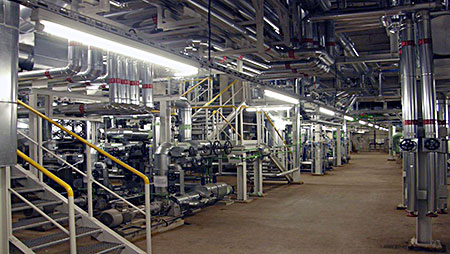A contribution to energy efficiency and climate protection
New high-efficiency power plants

After a construction phase of about three years, it was finally time for the exciting commissioning phase. The highlight of commissioning was the first power delivery on May 12, 2010 at about 19.00 hours, almost exactly 70 years after the very first commissioning of the Salzgitter power plant.
The various aggregates were commissioned by the end of 2010. The most important approvals had been obtained by December and, as a result, process optimizations could go ahead at the beginning of the new year.
Since commissioning, ongoing process optimizations have increased efficiency. Efficiency will be increased by more than 30 percent by mid-2012 compared with the old power plant.

With the new block power plants, we will be able to generate roughly 300,000 MWh more electricity per year than with the old power plant whilst consuming the same amount of fuel.
The generation of additional power is due to the increase in efficiency, which, in turn, is a result of higher steam parameters and sophisticated systems for preheating fuel.
The generation of additional power eases the burden on other power plants. This impacts the power generation mix in Germany, achieving a global CO2 reduction of approx. 200,000 tons per year.
Another positive aspect is the conservation of resources. As the district heating for neighboring industrial companies and parts of the city of Salzgitter is predominantly generated from cogeneration products (gases from steel production), important primary fuels, such as coal, oil or gas, are conserved.
The certificate on the left shows that we have a good primary energy factor of -1.04. The primary energy factor indicates how much primary energy has to be used in relation to useable thermal energy. This takes into account the loss incurred during the production, conversion and distribution of an energy source. The primary energy factor can be used to calculate energy efficiency and the careful use of resources. The more environmentally friendly the energy form and its conversion, the lower the primary energy factor – so a negative value is particularly good.
The construction of the new block plants represents a major step in environmental protection and the conservation of energy resources, ensuring the long-term supply of process steam, electricity and condensate to the production plants.







